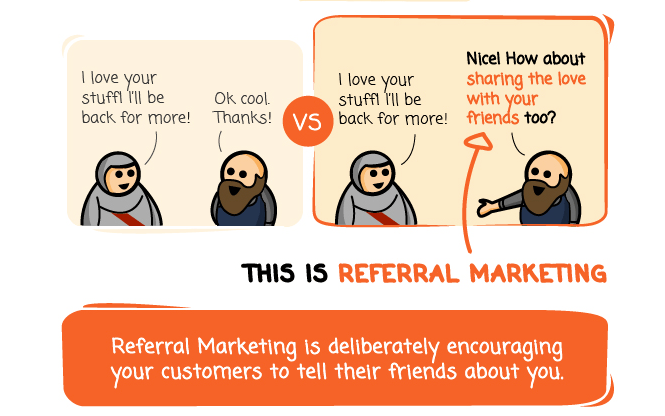Creating a Referral Marketing Program That Your Customers Will Love
Tips for creating and executing a successful referral marketing program that drives customer acquisition
and builds brand loyalty.
KEY TAKEAWAYS
● Referral marketing is a powerful way to grow your business and acquire new customers.
● A successful referral marketing program requires a clear strategy and a well-defined target
audience.
● Incentivizing both the referrer and the referee is important to encourage participation and
generate more referrals.
● Effective communication and follow-up with both parties are crucial to ensure a seamless and
rewarding experience.
● Measuring and analyzing the performance of your referral program is essential to optimize and
improve its effectiveness over time.
● Real-world examples of successful referral marketing programs can provide inspiration and
valuable insights for creating your program.
Referral marketing is a powerful tool that can help businesses boost customer acquisition, increase
brand loyalty, and drive revenue growth. By incentivizing existing customers to refer their friends and
family, businesses can tap into a valuable source of new leads and build stronger relationships with their
customer base. However, creating a successful referral marketing program requires careful planning and
execution. This article will explore the key strategies and tactics that businesses can use to create an
effective referral marketing program, including identifying the right incentives, leveraging technology and social media, and measuring the success of the program. Whether you are just starting with referral
marketing or looking to take your existing program to the next level, this guide will provide you with the
insights and tools you need to succeed.
Background
Referral marketing has become a popular strategy for businesses to acquire new customers and
increase brand loyalty. With the rise of social media and online reviews, customers have more power
than ever to influence their peers’ purchasing decisions. According to a study by Nielsen, 92% of
consumers trust recommendations from friends and family over all other forms of advertising. This makes
referral marketing an effective way to tap into the power of word-of-mouth marketing.
Referral marketing, also known as word-of-mouth marketing, is a strategy that encourages existing
customers to refer their friends, family, and colleagues to a business in exchange for an incentive. This
approach can help businesses acquire new customers at a lower cost than traditional advertising and
increase customer loyalty.
This article will discuss the key steps involved in creating a successful referral marketing program. You
will begin by exploring the benefits of referral marketing and the different types of referral marketing.
Next, you will delve into the process of building a referral marketing program, including setting goals and
objectives, identifying the target audience, creating an incentive program, developing a referral process,
and promoting the program. Finally, you will provide real-world examples of successful referral marketing
campaigns to inspire and guide your efforts.
Understanding Referral Marketing
Referral marketing is a marketing strategy that encourages existing customers to refer their friends,
family, and colleagues to a business. It is a cost-effective way of acquiring new customers and building
brand loyalty. Referral marketing can be executed through different methods, such as word-of-mouth
recommendations, social media sharing, and referral programs.
What is Referral Marketing?
Referral marketing is a marketing strategy that involves encouraging existing customers to refer new
customers to a business. It is based on the idea that satisfied customers are more likely to recommend a
product or service to their friends and family. Referral marketing relies on the power of word-of-mouth
recommendations and can be an effective way to acquire new customers and increase brand loyalty.
Benefits of Referral Marketing
Referral marketing offers several benefits for businesses, including:
● Cost-effective customer acquisition
● Increased brand awareness and credibility
● Higher conversion rates and customer lifetime value
● Improved customer retention and loyalty
Types of Referral Marketing
Referral marketing can take different forms, including:
● Word-of-mouth referrals
● Social media sharing
● Referral programs with incentives or rewards
By understanding the basics of referral marketing, businesses can leverage this strategy to acquire new
customers and increase brand loyalty.
Building a Referral Marketing Program
Referral marketing can be an effective strategy for increasing customer acquisition and building brand
loyalty. Here are some steps to build a successful referral marketing program:
Setting goals and objectives
Identify the specific goals and objectives of the program, such as increasing sales, acquiring new
customers, or improving brand awareness.
Identifying the target audience
Determine the target audience for the referral program. Who are the existing customers most likely to
refer their friends or family members to the business?
Creating an incentive program
Develop an incentive program that rewards both the referrer and the referred customer, such as
discounts, free products, or other perks.
Ensure that the incentives are appealing enough to motivate customers to refer others.
Developing a referral process
Create a clear and easy-to-follow referral process that customers can use to refer their friends or family
members.
Provide customers with the necessary tools, such as referral links, social media sharing buttons, or email
templates, to make it easier for them to refer others.
Promoting the program
Promote the referral program through various channels, such as social media, email campaigns, or on
the company’s website.
Use real-world scenarios or examples of successful referrals to encourage customers to participate in the
program.

Photo: Oberlo
By following these steps, businesses can build a successful referral marketing program that can help
increase customer acquisition and build brand loyalty.
Real-World Scenarios
Example of a Successful Referral Marketing Program
Referral marketing is a powerful tool for businesses looking to drive customer acquisition, build brand
loyalty, and increase ROI. A successful referral program will not only attract new customers but also
incentivize existing customers to keep coming back.
A great example of a successful referral program is Dropbox’s referral program. Launched in 2009,
Dropbox’s referral program has been instrumental in driving customer acquisition and exponential growth
for the company. The program offers users an incentive for referring their friends to the service: both the
referrer and referee receive an extra 500MB of storage for every successful referral.
Not only has this incentive been effective in driving customer acquisition, but it has also had a positive
effect on brand loyalty. As a result of the program, Dropbox has seen an increase in user engagement and customer retention, as customers are incentivized to keep referring to and using the service.
What Makes Dropbox’s Referral Program Successful?
The success of Dropbox’s referral program can be attributed to its simplicity and ease of use. The
program is easy to understand and use, requiring only a few clicks to get started. The incentive is also
designed to be attractive to both the referrer and referee, as both parties benefit from the program.
The program is also well-integrated with the user experience. Dropbox encourages referrals through a
variety of channels, including email, social media, and in-app notifications. This makes it easy for users
to share the program with their friends and family.
In addition, the program offers users an incentive that is tailored to their needs. The extra storage space
is an attractive offer for users, as it allows them to store more data and make better use of the service.
Case Study of a Referral Program
A great example of a successful referral program is the one used by the online retail company, Zappos.
The company launched its referral program in 2013 to increase customer acquisition and retention.
The program offered customers a 10% discount on their next purchase if they referred a friend to the
service. This incentive was designed to be attractive to both the referrer and referee, as both parties
benefited from the program.
In addition, the program was well-integrated with the user experience. Zappos encouraged referrals
through a variety of channels, including email, social media, and in-app notifications. This made it easy
for users to share the program with their friends and family.
The program was a success, and Zappos saw an increase in customer acquisition and retention as a
result. This case study shows the power of a well-designed referral program and the importance of
offering customers an incentive that is tailored to their needs.
Measuring the Success of Referral Marketing
1. Metrics to Track
Referral marketing programs can be a great way to acquire new customers and create brand loyalty.
However, it’s important to measure the success of the program to make sure it is achieving the desired
results. The key metrics to track when measuring the success of referral marketing programs include the
number of referrals, the conversion rate, the average order value, and the customer lifetime value (CLV).
Number of Referrals
The number of referrals is the most basic metric to measure the success of a referral marketing program.
It tells you how many people are participating in the program and how successful it is in spreading the
word about your brand.
Conversion Rate
The conversion rate is the percentage of referrals that turn into customers. It is important to track the
conversion rate because it shows the effectiveness of your program in converting referrals into
customers.
Average Order Value
The average order value (AOV) is the average amount of money spent by each customer who comes
through the referral program. This metric can be used to measure the success of the program in terms of
the amount of revenue it is generating.
Customer Lifetime Value
The customer lifetime value (CLV) is the total amount of money a customer will spend with your business
throughout their lifetime. This metric can be used to measure the success of the program in terms of the
long-term value it is generating.
2. Analyzing the Data
Once you have tracked the key metrics, it is important to analyze the data to get a better understanding
of the success of your referral marketing program. This can be done by comparing the data to your goals
and objectives, as well as to other marketing programs. This will allow you to identify areas of
improvement and determine if your program is meeting its goals.
3. Making Adjustments
Once you have analyzed the data, it is important to make adjustments to the program to make it more
successful. This could involve making changes to the referral reward structure, the messaging, or other
elements of the program. By making small adjustments and monitoring the results, you can ensure that
your referral marketing program is as successful as possible.
Measuring the success of referral marketing programs is essential to ensure they are achieving the
desired results. By tracking the key metrics, analyzing the data, and making adjustments, you can
maximize the success of your program and ensure it is meeting its goals.
Final Thoughts
Referral marketing can be an effective strategy for businesses looking to acquire new customers and
build brand loyalty. By understanding the basics of referral marketing and following the steps outlined in
this article, businesses can create successful referral programs that benefit both the referrer and the
referred. The key to success is setting clear goals, identifying the target audience, creating an attractive
incentive program, developing a referral process, and promoting the program through various channels.
It’s important to track the success of the program and make adjustments as needed to improve results.
With the power of social proof and word-of-mouth marketing, referral marketing can be a cost-effective
way to grow your customer base and increase brand awareness.


















































Comment Template